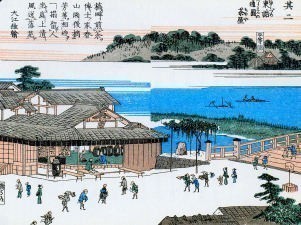Iris and I stayed at a popular Asakusa tourist hotel called Ryokan Shigetsu. Everyone seems to have heard of the place, and with good reason: they took very, very good care of us.
By the time we arrived at the Shigetsu, it was about 3am Seattle time and each of us was shocked that the other was still awake. We snuggled into our futons and went right to sleep…and woke up at 5am, just like everyone warned us we would. So we read our books ([Neuromancer](http://www.amazon.com/dp/0441012035/?tag=mamstesgrubshack) and [The Pirates’ Mixed-up Voyage](http://www.amazon.com/dp/0140371281/?tag=mamstesgrubshack), respectively) until breakfast.
The Shigetsu is a little six-story hotel in the middle of Asakusa. We chose Asakusa because we’d heard it was a classic, old-school Tokyo neighborhood, which it was. Every time we went out, we walked past a new interesting window to peek in, which is not an experience unique to Asakusa, but it made going out that much more fun. We saw an old man hand-cutting soba noodles in the window of a restaurant, and a knife shop with a sharpening stone in the window that I happen to have at home. (Iris and I were, for some reason, unreasonably proud of this.) We saw people making red bean cakes using a device very similar to a sandwich press my parents had when I was a kid, used for cooking sandwiches over a campfire. The red bean cakes smelled fabulous, and we stopped to buy some on the way to dinner one night. They tasted like cake with beans in the middle. Red bean paste is a Japanese taste I haven’t acquired yet.
One nice thing about Asakusa is that the blocks are very, very short. What looks like a long walk on the map is probably a short walk. Just east of the Shigetsu is Nakamise-dori, the tourist shopping street:
That’s Nakamise-dori one morning before most of the shops opened. (We were waking up before 6am for a few days before we got onto Japan time.) It’s mostly junky souvenirs, but there are many makers of _senbei,_ rice crackers, which are exactly like the soy sauce-flavored rice crackers you get in an assortment at the supermarket, but much fresher; the most popular kind is larger than a silver dollar and must be eaten in several hearty bites. These are addictive. Iris, of course, loved Nakamise-dori, and she took her spending money and promptly bought three different stuffed cats. Mission accomplished.
Now, back to the Shigetsu. Iris and I are still reminiscing about how comfortable the futons were. We slept fabulously, and not just because we wore ourselves out on a daily basis. The room was absolutely tiny. A real estate ad would have called it “cozy.”
In the corridor on the way to the elevator was a tiny plant that the staff changed daily. And on the sixth floor was the hot bath.
Public baths are Japanese tradition, and if the public bath is a big wooden bathtub on the top floor of a small hotel, that’s good enough. Or better. Every night, we put on our yukatas:
and went up to the hot bath, which was almost always deserted. (I took Iris into the men’s bath with me; next time she’ll be old enough to go to the women’s bath alone, so I’m glad we went when we did.) The bath was very hot, and it had a view of the temple spire and some nearby skyscrapers. When we got into the tub, water spilled over the edge and seeped through the floorboards, something I’m always warning Iris not to do at home but which is totally expected in a Japanese bath.
On [the day we got lost in Uji](https://www.rootsandgrubs.com/2010/05/03/udon-with-the-fox-goddess/) and got back to Tokyo late and hungry, we got to the Shigetsu and Iris said, “I’m so glad we’re home.” It’s that kind of place.
**Next:** A day on Odaiba. Oh, and I wrote about [chicken tail](http://www.culinate.com/columns/bacon/yakitori_grilling_meat_on_a_stick) on Culinate.








